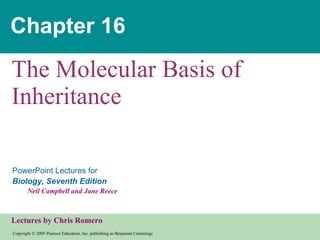Melden
Teilen

Weitere ähnliche Inhalte
Was ist angesagt?
Was ist angesagt? (11)
BIOLOGY FORM 5 CHAPTER 5 - 5.3 D Genetic Engineering

BIOLOGY FORM 5 CHAPTER 5 - 5.3 D Genetic Engineering
Andere mochten auch
Andere mochten auch (20)
Concurrent synthesis on the leading and lagging strands

Concurrent synthesis on the leading and lagging strands
Ähnlich wie Chapter 16
Ähnlich wie Chapter 16 (20)
Chapter16 inheritance-151125150159-lva1-app6891 (1)

Chapter16 inheritance-151125150159-lva1-app6891 (1)
genetic material in organization, Central dogma,transcription in prokaryotes ...

genetic material in organization, Central dogma,transcription in prokaryotes ...
Mehr von ktanaka2
Mehr von ktanaka2 (18)
Kürzlich hochgeladen
Kürzlich hochgeladen (20)
Scale your database traffic with Read & Write split using MySQL Router

Scale your database traffic with Read & Write split using MySQL Router
The Fit for Passkeys for Employee and Consumer Sign-ins: FIDO Paris Seminar.pptx

The Fit for Passkeys for Employee and Consumer Sign-ins: FIDO Paris Seminar.pptx
[Webinar] SpiraTest - Setting New Standards in Quality Assurance![[Webinar] SpiraTest - Setting New Standards in Quality Assurance](data:image/gif;base64,R0lGODlhAQABAIAAAAAAAP///yH5BAEAAAAALAAAAAABAAEAAAIBRAA7)
![[Webinar] SpiraTest - Setting New Standards in Quality Assurance](data:image/gif;base64,R0lGODlhAQABAIAAAAAAAP///yH5BAEAAAAALAAAAAABAAEAAAIBRAA7)
[Webinar] SpiraTest - Setting New Standards in Quality Assurance
DevEX - reference for building teams, processes, and platforms

DevEX - reference for building teams, processes, and platforms
Modern Roaming for Notes and Nomad – Cheaper Faster Better Stronger

Modern Roaming for Notes and Nomad – Cheaper Faster Better Stronger
UiPath Community: Communication Mining from Zero to Hero

UiPath Community: Communication Mining from Zero to Hero
Assure Ecommerce and Retail Operations Uptime with ThousandEyes

Assure Ecommerce and Retail Operations Uptime with ThousandEyes
Long journey of Ruby standard library at RubyConf AU 2024

Long journey of Ruby standard library at RubyConf AU 2024
Time Series Foundation Models - current state and future directions

Time Series Foundation Models - current state and future directions
Merck Moving Beyond Passwords: FIDO Paris Seminar.pptx

Merck Moving Beyond Passwords: FIDO Paris Seminar.pptx
Use of FIDO in the Payments and Identity Landscape: FIDO Paris Seminar.pptx

Use of FIDO in the Payments and Identity Landscape: FIDO Paris Seminar.pptx
The Role of FIDO in a Cyber Secure Netherlands: FIDO Paris Seminar.pptx

The Role of FIDO in a Cyber Secure Netherlands: FIDO Paris Seminar.pptx
Why device, WIFI, and ISP insights are crucial to supporting remote Microsoft...

Why device, WIFI, and ISP insights are crucial to supporting remote Microsoft...
Emixa Mendix Meetup 11 April 2024 about Mendix Native development

Emixa Mendix Meetup 11 April 2024 about Mendix Native development
Take control of your SAP testing with UiPath Test Suite

Take control of your SAP testing with UiPath Test Suite
Chapter 16
- 1. Chapter 16 The Molecular Basis of Inheritance
- 19. O – O O OH O – O O O H 2 C O – O O O H 2 C O – O O O OH O O O T A C G C A T O O O CH 2 O O – O O CH 2 CH 2 CH 2 5 end Hydrogen bond 3 end 3 end G P P P P O OH O – O O O P P O – O O O P O – O O O P (b) Partial chemical structure H 2 C 5 end Figure 16.7b O
- 21. N H O CH 3 N N O N N N N H Sugar Sugar Adenine (A) Thymine (T) N N N N Sugar O H N H N H N O H H N Sugar Guanine (G) Cytosine (C) Figure 16.8 H
- 27. CONCLUSION Meselson and Stahl concluded that DNA replication follows the semiconservative model by comparing their result to the results predicted by each of the three models in Figure 16.10. The first replication in the 14 N medium produced a band of hybrid ( 15 N– 14 N) DNA. This result eliminated the conservative model. A second replication produced both light and hybrid DNA, a result that eliminated the dispersive model and supported the semiconservative model. First replication Second replication Conservative model Semiconservative model Dispersive model
- 38. Overall direction of replication 3 3 3 3 5 3 5 3 5 3 5 3 5 3 5 3 5 3 5 5 1 1 2 1 1 2 5 5 1 2 3 5 Template strand RNA primer Okazaki fragment Figure 16.15 Primase joins RNA nucleotides into a primer. 1 DNA pol III adds DNA nucleotides to the primer, forming an Okazaki fragment. 2 After reaching the next RNA primer (not shown), DNA pol III falls off. 3 After the second fragment is primed. DNA pol III adds DNA nucleotides until it reaches the first primer and falls off. 4 DNA pol 1 replaces the RNA with DNA, adding to the 3 end of fragment 2. 5 DNA ligase forms a bond between the newest DNA and the adjacent DNA of fragment 1. 6 The lagging strand in this region is now complete. 7